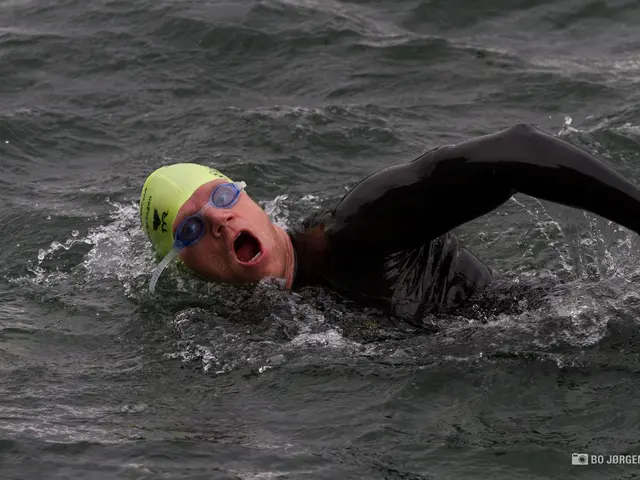Frogfish Details: Facts, Classification, Habits, Photography Sessions
In the depths of the ocean, a small, spiny creature awaits, blending seamlessly with its surroundings. This is the Hairy Frogfish, Antennarius striatus, a unique and elusive species that has captured the attention of underwater photographers worldwide.
Hairy frogfish are typically around 8 inches long and are known for their unusual appearance. They come in various forms, often striped or with hairy appendages, and can change their colouration to match their habitat, aiding in camouflage on coral reefs or rocky areas.
These small predators are ambush hunters, equipped with a specialized lure called an Esca. The lure, resembling a wriggling worm, is used to attract prey, which they then swallow whole using suction. Their mouths are large enough to consume prey about their own size, including other frogfish.
Unlike many fish, hairy frogfish have angled pectoral fins enabling them to "hop" along the ocean floor rather than swim continuously. They are found in tropical and subtropical waters worldwide, including the Pacific, Atlantic, and Indian Oceans, the Gulf of America, and the Caribbean Sea. Commonly, they inhabit coral reefs, rocky areas, rubble, and debris on the ocean floor, from near the surface to depths of around 600 feet.
For those seeking to observe these fascinating creatures, tropical coral reefs in the Indo-Pacific (such as Indonesia), Caribbean Sea, and other tropical regions where coral structures provide camouflage and abundant prey are prime areas. These habitats offer the rubble, coral, and rocky substrates favoured by hairy frogfish.
The Hairy Frogfish is not the only species in the Antennarius genus. The Warty Frogfish, Antennarius maculatus, is another well-known species. Juvenile warty frogfish are yellow with red-brown saddles and orange borders of rear dorsal and tail fins. As they mature, they develop a yellow colour with a red-brown saddle and orange borders on their rear dorsal and tail fins.
Another species, the Painted Frogfish, Antennarius pictus, can change its colour to match various hues such as white, black, red, pink, orange, yellow, and brown.
While most frogfish are not poisonous, there are a few species of toadfish that are poisonous in the family Batrachoididae.
Patience is key when it comes to underwater photography of frogfish, with lens choices ranging from 105mm to 10.5mm. Side lighting is best for intricate detail of camouflage patterns, and focus locking is useful for rapid fire photos or to shoot while yawning and for black objects. Never herd frogfish together for cute photos, and use shallow depth of field to create bokeh in the background, helping to isolate the frogfish from the substrate. Use inward-facing strobe positioning to create a black background behind the frogfish, and leave space in the frame for behaviour shots.
In conclusion, the Hairy Frogfish, Antennarius striatus, is a small, spiny, and colour-changing creature that can be found in tropical and subtropical waters worldwide. They are ambush predators, using a specialized lure to attract prey, and are found in coral reefs, rocky areas, rubble, and debris on the ocean floor. The best places to find these elusive creatures include tropical coral reefs in the Indo-Pacific, Caribbean Sea, and other tropical regions.
- The Hairy Frogfish is typically around 8 inches long and is known for its unusual appearance.
- They are known for their ability to change their coloration to match their habitat for camouflage.
- Hairy frogfish are ambush hunters, equipped with a specialized lure called an Esca.
- The lure, resembling a wriggling worm, is used to attract prey, which they then swallow whole.
- Unlike many fish, hairy frogfish have angled pectoral fins enabling them to "hop" along the ocean floor.
- They are found in tropical and subtropical waters worldwide, including the Pacific, Atlantic, and Indian Oceans.
- Commonly, they inhabit coral reefs, rocky areas, rubble, and debris on the ocean floor, from near the surface to depths of around 600 feet.
- For those seeking to observe these fascinating creatures, tropical coral reefs in the Indo-Pacific, Caribbean Sea, and other tropical regions where coral structures provide camouflage and abundant prey are prime areas.
- The Warty Frogfish, Antennarius maculatus, is another well-known species in the Antennarius genus.
- Juvenile warty frogfish are yellow with red-brown saddles and orange borders of rear dorsal and tail fins.
- As they mature, they develop a yellow colour with a red-brown saddle and orange borders on their rear dorsal and tail fins.
- Patience is key when it comes to underwater photography of frogfish, with lens choices ranging from 105mm to 10.5mm.
- Best lighting for intricate detail of camouflage patterns is side lighting, and focus locking is useful for rapid fire photos or to shoot while yawning and for black objects.
- Use inward-facing strobe positioning to create a black background behind the frogfish, and leave space in the frame for behavior shots in fashion-and-beauty, food-and-drink, home-and-garden, relationships, pets, travel, education-and-self-development, or sports lifestyle.




